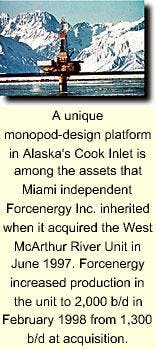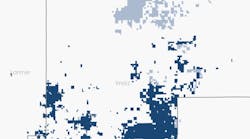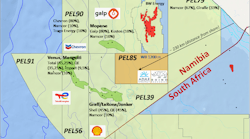While most of Alaska's exploratory interest focuses on the North Slope, the state's original commercial producing area-the Cook Inlet basin-still holds some exploratory and development interest.
Forcenergy Inc., A Miami independent, is setting the stage for an exploratory well that might put a long-denied offshore Cook Inlet oil field in the producing column for the first time, more than 32 years after its discovery.
The field is Redoubt Shoal, 5 miles southwest of Middle Ground Shoal field, which is 5 miles southwest of Anchorage.
Pan American Petroleum Corp. discovered Redoubt Shoal field in September 1968, with Redoubt Shoal State 2690 No. 1, 13-7n-14w. The well flowed 1,400 b/d of 28.2° gravity oil through a 2-in. choke from Hemlock conglomerate at 13,260-13,845 ft. Originally spudded on Aug. 26, 1967, the well had been suspended on Dec. 13, 1967, at 13,991 ft. The hole was redrilled and deepened to 14,060 ft. The directional drilling job by Penrod Drilling Co.'s No. 66 jack up put the bottom of the well in the northwest quarter of 19-7n-13w. The well has been shut in since 1968.
Forecenergy program
Forcenergy entered the scene in October 1998 with acquisition of eight leases from Danco Exploration, Houston, five of which comprised the Redoubt Shoal Unit.
The program called for construction of a portable drilling platform to be built in Ulsan, South Korea, and delivered in April 1999. The platform was to come over on a submersible, heavy-lift vessel and placed for use as an offshore drilling platform. The cost of platform and such necessities as quarters and cranes designed to be able to pick up the drilling rig were expected to come in at $35-40 million before everything was ready to contract the drilling rig, pick it up, and begin drilling. The goal was to spud by October 1999.
If exploration of the Redoubt Shoal prospect proved successful, the platform might be left in place as a production platform. If exploration did not prove up commercial potential, the platform might be used to test other prospects identified by extensive 3D seismic in the Cook Intlet.
Financing problems postponed the $35 million offshore platform project this summer, and Forcenergy's partner, Unocal Corp., dropped out of the project. Early in March, Gary Carlson, Forcenergy's Alaska manager, said the project had been postponed for at least 3 months and maybe until 2000.
Forcenergy had planned to install the platform, known as its Osprey project, in May. Despite its oil price-driven troubles, Forcenergy pushed ahead with the Redoubt Shoal project because of the long lead time required for offshore exploration in Alaska. There is still optimism, in fact, that reserves are larger than the estimated 40 million bbl of oil.
Work on the Forcenergy living quarters set a record. The $4.3 million, 50-worker living quarters module that VECO Corp. built this past winter for Forcenergy in Anchorage was completed in a record 31/2 months. The real challenge in building this module was the brief nature of the project, according to Tom Arnold, VECO's project manager: "It required a lot of coordination between the engineers, the construction team, and the subcontractors, with some design work going on at the same time that construction was under way."
VECO was assisted by nine subcontractors: 80-100 workers built the module, and 95% of materials and supplies were purchased in Alaska.
It is believed drilling will get under way in 2000 in 45 ft of water where the platform will be placed, serving as a site for directional holes programmed to 14,000-18,000 ft in the campaign to put Redoubt Shoal on production.
Other exploration
Meanwhile, a deep exploratory well has been drilled in the Cook Inlet Basin, in 6-11n-9w, by Phillips Petroleum Co. The classification was reported as: Development, 1-Oil. The completion date was Dec. 1, 1998. Total depth was 16,720 ft, true vertical depth 12,941 ft. The rig was Pool Arctic's No. 428. Further details were not released.
In other action, Marathon Oil Co. proved there is potential for new gas discoveries in the mature Cook Inlet basin. The company found gas in commercial quantities in undefined pools near Sterling Gas field on the Kenai Peninsula. Targets were undefined pools in Beluga and Tyonek sands. The well classification was reported as: Development, 2-Gas; Sterling Beluga Undefined Gas Pool, Sterling Tyonek Undefined Gas Pool. The discovery well was Sterling Unit No. 41-15, in 9-5n-10w. Completion date for the Sterling well was Jan. 19, 1999. Total depth for the Sterling Unit No. 41-15 was 12,600 ft, true vertical depth 10,559 ft. Active pool production for April 1999 was: Beluga Undefined Pool, 3.253 MMcf; and Tyonek Undefined Pool, 4.019 MMcf.




